Related Research Articles
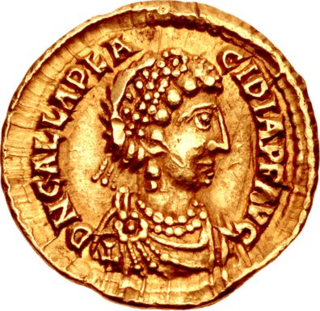
Galla Placidia, daughter of the Roman emperor Theodosius I, was a mother, tutor, and advisor to emperor Valentinian III. She was queen consort to Ataulf, king of the Visigoths from 414 until his death in 415, briefly empress consort to Constantius III in 421, and managed the government administration as a regent during the early reign of Valentinian III until her death.
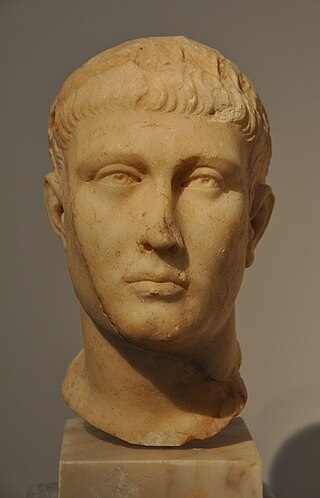
Theodosius I, also called Theodosius the Great, was a Roman emperor from 379 to 395. During his reign, he succeeded in a crucial war against the Goths, as well as in two civil wars, and was instrumental in establishing the creed of Nicaea as the orthodox doctrine for Christianity. Theodosius was the last emperor to rule the entire Roman Empire before its administration was permanently split between the West and East.
The 390s decade ran from January 1, 390 to December 31, 399

Magnus Maximus was Roman emperor in the West from 383 to 388. He usurped the throne from emperor Gratian.

Gratian was emperor of the Western Roman Empire from 367 to 383. The eldest son of Valentinian I, Gratian was raised to the rank of Augustus as a child and inherited the West after his father's death in 375. He nominally shared the government with his infant half-brother Valentinian II, who was also acclaimed emperor in Pannonia on Valentinian's death. The East was ruled by his uncle Valens, who was later succeeded by Theodosius I.
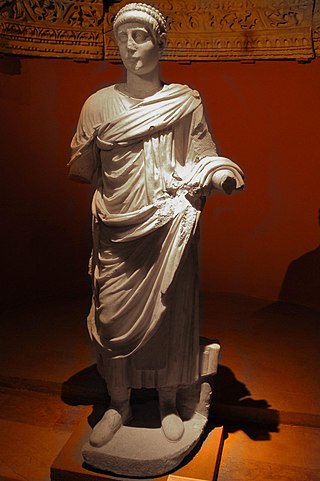
Valentinian II was a Roman emperor in the western part of the Roman empire between AD 375 and 392. He was at first junior co-ruler of his half-brother, then was sidelined by a usurper, and finally became sole ruler after 388, albeit with limited de facto powers.
Count Theodosius or Theodosius the Elder, was a senior military officer serving Valentinian I and the Western Roman Empire during Late Antiquity. Under his command the Roman army defeated numerous threats, incursions, and usurpations. Theodosius was patriarch of the imperial Theodosian dynasty and father of the emperor Theodosius the Great.
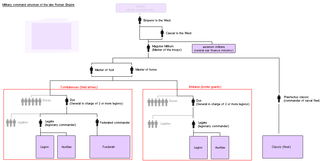
Magister militum was a top-level military command used in the later Roman Empire, dating from the reign of Constantine the Great. The term referred to the senior military officer of the empire. In Greek sources, the term is translated either as strategos or as stratelates.

Eugenius was a Western Roman emperor from 392 to 394, unrecognized by the Eastern Roman emperor Theodosius I. While Christian himself, Eugenius capitalized on the discontent in the West caused by Theodosius' religious policies targeting pagans. He renovated the pagan Temple of Venus and Roma and restored the Altar of Victory after continued petitions from the Roman Senate. Eugenius replaced Theodosius' administrators with men loyal to him including pagans. This revived the pagan cause. His army fought the army of Theodosius at the Battle of the Frigidus, where he was captured and executed.

Victor was a Western Roman emperor from either 383/384 or 387 to August 388. He was the son of the magister militum Magnus Maximus, who later became a usurper of the Western Roman Empire, in opposition to Gratian. Maximus rose up in 383, and was recognized as the legitimate emperor in the west by Theodosius I. Victor was elevated to augustus of the Western Roman Empire in either 383/384 or mid-387, making him co-emperor with his father. Maximus invaded Italy in 387, to depose Valentinian II, the brother and successor of the late Gratian. Because of Maximus' invasion, Theodosius invaded the Western Empire in 388. Theodosius defeated Maximus in two battles in Pannonia, before crushing his army at Aquilea, and capturing Maximus. Maximus was executed on 28 August 388. His death was followed quickly by that of Victor, who was executed in Trier by the Frankish general Arbogast.

The Theodosian dynasty was a Roman imperial family that produced five Roman emperors during Late Antiquity, reigning over the Roman Empire from 379 to 457. The dynasty's patriarch was Theodosius the Elder, whose son Theodosius the Great was made Roman emperor in 379. Theodosius's two sons both became emperors, while his daughter married Constantius III, producing a daughter that became an empress and a son also became emperor. The dynasty of Theodosius married into, and reigned concurrently with, the ruling Valentinianic dynasty, and was succeeded by the Leonid dynasty with the accession of Leo the Great.
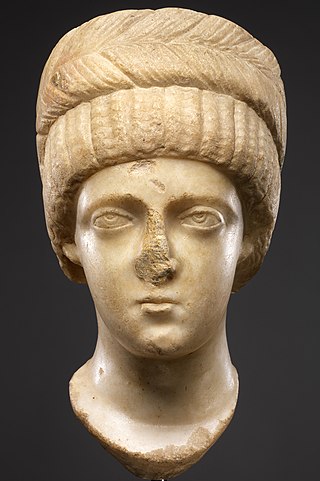
Aelia Flavia Flaccilla was a Roman empress and first wife of the Roman Emperor Theodosius I. She was of Hispanian Roman descent. During her marriage to Theodosius, she gave birth to two sons – future Emperors Arcadius and Honorius – and a daughter, Aelia Pulcheria.

The Battle of the Frigidus, also called the Battle of the Frigid River, was fought on 5 and 6 September 394 between the armies of the Roman emperor Theodosius the Great and the rebel augustus Eugenius, in the eastern border of Roman Italy. Theodosius won the battle and defeated the usurpation of Eugenius and Arbogast, restoring unity to the Roman Empire. The battlefield, in the Claustra Alpium Iuliarum near the Julian Alps through which Theodosius's army had passed, was probably in the Vipava Valley – with the Frigidus River being the modern Vipava – or possibly in the valley of the Isonzo.

The Valentinian dynasty was a ruling house of five generations of dynasts, including five Roman emperors during late antiquity, lasting nearly a hundred years from the mid fourth to the mid fifth century. They succeeded the Constantinian dynasty and reigned over the Roman Empire from 364 to 392 and from 425 to 455, with an interregnum (392–423), during which the Theodosian dynasty ruled and eventually succeeded them. The Theodosians, who intermarried into the Valentinian house, ruled concurrently in the east after 379.
Justina was a Roman empress. She was initially the wife of the rebel emperor Magnentius and was then married to Valentinian I, with whom she had four children, including the emperor Valentinian II and the empress Galla.
Galla was a Roman empress as the second wife of Theodosius I. She was the daughter of Valentinian I and his second wife Justina.
Flavius Bauto was a Romanised Frank who served as a magister militum of the Roman Empire and imperial advisor under Valentinian II.
Flavius Richomeres or Ricomer was a Frank who lived in the late 4th century. He took service in the Roman army and made a career as comes, magister militum, and consul. He was an uncle of the general Arbogastes. He is possibly to be identified with the Richomeres who married Ascyla, whose son Theodemer later became king of the Franks.
Flavius Merobaudes was a Roman army officer of Frankish origin. He was appointed magister peditum around 375, and consul twice in 377 and 383. Ancient sources record that he was put to death that year for his support of the imperial usurper Magnus Maximus, but an inscription records that he became consul a third time in 388.
The persecution of pagans under Theodosius I began in 381, after the first couple of years of his reign as co-emperor in the eastern part of the Roman Empire. In the 380s, Theodosius I reiterated the ban of Constantine the Great on animal sacrifices, prohibited haruspicy on animal sacrifice, pioneered the criminalization of magistrates who did not enforce anti-pagan laws, broke up some pagan associations and destroyed pagan temples.
References
- ↑ Jones, Martindale & Morris, pp. 765–766.
- ↑ Socrates, ch. XXV, p. 297 https://archive.org/details/ecclesiasticalh02valogoog/page/296/mode/2up
- ↑ Ludwig, p. 60
- ↑ Jones, Martindale & Morris, p. 97.
- ↑ Cameron, Alan (2010). The Last Pagans of Rome. Oxford University Press. pp. 85–86.
- ↑ Zosimus, IV. 33 p. 165
- ↑ Jones, Martindale & Morris, pp. 933–934.
- ↑ Croke 1976, p. 236.
- ↑ Burns 1994, p. 75.
- ↑ Orosius, Histories 7.35.11
- ↑ Edward Gibbon, The Decline And Fall Of The Roman Empire, (The Modern Library, 1932), chap. XXVI, p. 933; chap. XXVII, pp. 961, 994
- ↑ Jones, Martindale & Morris, pp. 159–160.
- ↑ Jones, Martindale & Morris, pp. 904–905.
- ↑ Wolfram, pp. 132–134
- ↑ Jones, Martindale & Morris, p. 588.
- ↑ Cambridge Medieval History, p. 383
- ↑ Gibbon, p. 994
- ↑ Williams & Friell 1994, p. 62.
- ↑ Williams & Friell 1994, p. 63.
- ↑ Zosimus, IV. 47 p. 180
- ↑ Croke 1976, p. 235.
- 1 2 Zosimus, IV. 53 p. 186
- 1 2 3 4 Williams & Friell 1994, p. 126.
- ↑ Gregory of Tours, II.9 p. 122
- ↑ Hodgkin, pp. 551–552
- ↑ Hodgkin, p. 554
- 1 2 Williams & Friell 1994, p. 127.
- ↑ Philostorgius, 11.9 p. 143
- 1 2 Matthews, p. 238
- ↑ Ambrose, p. 358
- ↑ Ambrose, p. 359
- ↑ Rufinus, XI. 31
- ↑ Zosimus, IV. 54 pp. 186–187
- ↑ Philostorgius, 11.1, p. 143
- ↑ Socrates, 5.11
- ↑ Orosius, 7.35
- ↑ Gibbon, ch 27
- ↑ Croke 1976, p. 244.
- ↑ Hodgkin, p. 592
- ↑ Jones, Martindale & Morris, p. 293.
- 1 2 Burns 1994, p. 104.
- 1 2 3 Williams & Friell 1994, p. 129.
- ↑ Gregory of Tours, II.9, p. 122
- ↑ Hodgkin, p. 560
- ↑ Zosimus, IV. 54 p. 187
- ↑ Salzman, "Ambrose and the Usurpation of Arbogastes and Eugenius"
- ↑ Paulinus, p. 106
- ↑ Williams & Friell 1994, p. 128.
- ↑ Jones, Martindale & Morris, p. 630.
- ↑ Williams & Friell 1994, p. 130.
- ↑ Paulinus, p. 108
- ↑ Socrates, 5.18.14.
- ↑ Williams & Friell 1994, p. 132.
- ↑ Burns 1994, pp. 104–107.
- ↑ Williams & Friell 1994, pp. 132–134.
- ↑ Hebblewhite 2020, pp. 137–140.
- ↑ Burns 1994, p. 105.
- ↑ Williams & Friell 1994, pp. 134–135.
- ↑ Hodgkin, p. 559
Sources
This article lacks ISBNs for the books listed.(September 2018) |
- Ambrose (2005). Liebeschuetz, John Hugo Wolfgang Gideon (ed.). Political Letters and Speeches . Liverpool: Liverpool University Press. ISBN 978-1-846-31243-4.
- Gregory of Tours (1974). The History of the Franks Translated with an introduction by Lewis Thorpe. England: Penguin Classics. ISBN 978-0-14-044295-3.
- Orosius, Paulus (2002). The Seven Books of History Against the Pagans. Washington, D.C.: Catholic University of America Press. ISBN 978-0-8132-1310-1.
- Ludwig, Uwe; Schilp, Thomas (2008). Nomen et Fraternitas: Festschrift für Dieter Geuenich zum 65. Geburtstag (in German). Berlin: Walter de Gruyter. ISBN 978-3-11-916712-3.
- Paulinus of Nola (1999). Trout, Dennis (ed.). Life, Letters, and Poems. Transformation of the Classical Heritage (first ed.). Berkeley: University of California Press. ISBN 978-0-520-21709-6.
- Rufinus. Historia Ecclesiastica. Edited by T. Mommsen. Berlin, 1903–1908.
- Amidon, Philip, ed. (2007). Philostorgius: Church History. Writings from the Greco-Roman World. Atlanta: Society of Biblical Literature. ISBN 978-1-58983-215-2.
- Socrates. Historia Ecclesiastica. With introduction by W.Bright. Oxford, 1878.
- Zosimus. Historia Nova, The Decline of Rome. Translated by James Buchanan and Harold Davis. Trinity University Press. Texas, 1967.
- Burns, Thomas S. Barbarians Within the Gates of Rome : A Study of Roman Military Policy and the Barbarians, ca. 375–425 A.D. Indiana University Press 1994. ISBN 978-0-253-31288-4.
- Croke, B (1976), "Arbogast and the Death of Valentinian II", Historia, 25 (2).
- Williams, Stephen; Friell, Gerard (1994). Theodosius: The Empire at Bay. Yale University Press. ISBN 978-0-300-07447-5.
- Gibbon, Edward (1826). The History of the Decline and Fall of the Roman Empire. J. & J. Harper.
- Hebblewhite, Mark (2020). Theodosius and the Limits of Empire. London: Routledge. doi:10.4324/9781315103334. ISBN 978-1-138-10298-9. S2CID 213344890.
- Hodgkin, Thomas (1982). Italy and Her Invaders: pt. 1–2. The Visigothic invasion. Clarendon Press.
- Jones, A.H.M.; J.R. Martindale & J. Morris (1971). Prosopography of the Later Roman Empire. Vol. 1. Cambridge University Press. ISBN 0-521-07233-6.
- Matthews, John (1975). Western Aristocracies and Imperial Court, A.D. 364–425. Oxford: Clarendon Press. ISBN 978-0-19-814499-1.
- Salzman, Michele Renee. Ambrose and the Usurpation of Arbogastes and Eugenius: Reflections on Pagan-Christian Conflict Narratives. Journal of Early Christian Studies – Volume 18, Number 2, Summer 2010, pp. 191–223. The Johns Hopkins University Press.
- Wolfram, Herwig and Dunlap, Thomas. History of the Goths. Berkeley: University of California Press, 1990. ISBN 978-0-520-06983-1
- "Chapter VIII. The Dynasty of Valentinian and Theodosius the Great". The Death of Gratian 383. Cambridge Medieval History. Archived from the original on 9 February 2011. Retrieved December 15, 2010.
Further reading
- Bloch, H. (1945). "A New Document of the Last Pagan Revival in the West 392–394 A.D". Harvard Theological Review. 38 (4): 225. doi:10.1017/S0017816000022793. S2CID 162536717.
- Potter, David. From the Tetrarch To the Theodosians: Later Roman History and Culture 284–450 CE